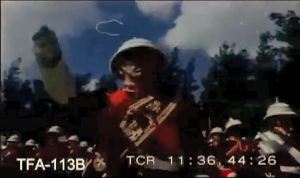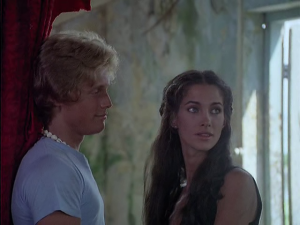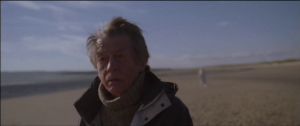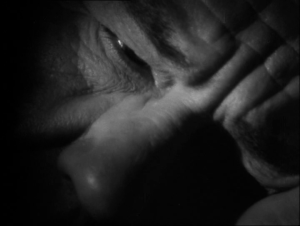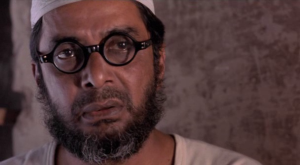An Ocean Full Of Faces
A bright full moon pushes through the blue haze of the daytime sky over The Settlement. The warm November breezes herald the approach of another hot sub-tropical summer, and excuses are made all through the town to eschew haste for leisurely engagement to the business of survival. Yet some of the island’s inhabitants have no time for this relaxed philosophy. From all directions They come, caring nothing for demarcation lines between man and motor. On every pavement, in every street, across every veranda, and through every backyard, they cover the town in a scuttling sea of red. One hundred million bundles of busy legs exchanging their sunless burrows for the shining, sandy shores of the beaches beyond the palm trees and the bubbling blue waters of the ocean beyond. Not for them the pleasures of this sinewave surfer’s paradise, but the unquestioning duty, the unwavering need to spawn the future. Just as they did last year, just as they will next year and for all the years to follow. They are the red crabs of Christmas Island.
“The whole place is overrun with curious red crabs as much as 18S in. across. They are excellent tree climbers, and once a year there is a regular migration of these crustaceans who travel in bodies like ants, taking 15 days on the journey, and returning inland after hatching their eggs.” – The Examiner – Launceston, Tasmania, 14 May, 1901, expedition of Sir John Murray.
In 2002, the Australian documentary series Island Life explored the far-reaching impact of this remarkable species, endemic only to Christmas and Cocos Islands (both Australian territories), and the increasing threats it faces by humanity and its influence. Two in particular currently affect the fate of the red crabs. Caring little for the presence of Christmas Island’s self-appointed owners – predominantly European and Chinese – crabs unwittingly braving the tarmac often fall victim to the heavy tyres of mining trucks filled with the precious phosphate that gives the locals their main economy. Fortunately, miners are reasonable people and awareness programs have made good progress in teaching them of the importance of preserving the rare local fauna.
“On every pavement, in every street, across every veranda, and through every backyard, they cover the town in a scuttling sea of red.”
Far less reasonable is the second, and far more deadly, threat the red crabs face. Accidentally introduced into the local ecology from Africa a century ago, the yellow crazy ant today decimates all that stands in its path. “Listed among the 100 most devastating invaders of the world,” says Wikipedia (the entry has an extensive references section), “it has invaded ecosystems from Hawaii to Seychelles, and formed supercolonies on Christmas Island in the Indian Ocean.” Formic acid, their chief method of attack, blinds their prey, eroding areas of its body or simply causing it to starve to death. Large and unwieldy in comparison to its tiny and determined predator, the red crab has little chance of escape. Equally disadvantaged are its distant relative, the coconut (robber) crab, and other mammals and plant life sharing the surrounding environment.
The outlook was fairly grim in 2002, with fully a third of the total red crab population wiped out by the unstoppable invaders. That same year however saw major countermeasures launched by local wildlife officers. Ground and aerial baiting efforts using fipronil, a fish protein-based poison lethal to insects but not their victims, has proved highly successful in curbing the yellow crazy ant population. Like the Borg, however, the interlopers do not give up easily, and the long battle continues, the standing death toll massive. For the time being at least, the red crabs continue to fill the streets for every November’s mass migration.
*****
It was the terror of the seas. Its name was spoken with fear and awe. It had weaved a path of destruction that was spoken of with disbelief in every port across the South China Sea. Now it’s luck was about to run out as it headed for the remote, palm-covered atolls known by their inhabitants as the Keeling Islands. The final battle was about to begin.
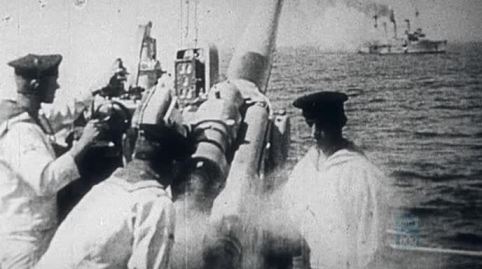
The infamous SMS Emden meets its match during the Battle of Cocos, one of the first naval conflicts of World War I.
Once the private retreat of a rich Englishman and his harem of forty Malay women, today’s Cocos (Keeling) Islands are a quiet adjunct of Western Australia and home to a small population of Europeans and Malaysians who make a living from tourism. Sitting about halfway between Australia and Sri Lanka, the Cocos have always been of strategic importance because of their location within major shipping lanes. This was all the more important in 1914 when the crew of the German cruiser SMS Emden, after months of successfully capturing and sinking almost every Allied ship it had encountered between Bengal and Keeling, decided to make for the Cocos and disable the vital wireless and cable relay on the archipelago’s Direction Island. Not only were the Cocos important to shipping during World War I, serving as a stopover point for ANZACS headed to the Turkish battlefield, but also a vital communications link between Australasia and Europe. For the other side therefore, it was an important link to sever.
The Battle of Cocos began on November 9th, 1914, when a landing party from the Emden stormed Direction Island and destroyed the relay station. Unbeknownst to the Emden was the fact that long before their plans of sabotage had been made, a convoy of ANZAC ships bound for Turkey were at this moment heading through the Indian Ocean. To make matters worse, one of the locals had managed to send an SOS to Allied forces before the communications station was damaged. Dispatched from the convoy to investigate the message, the Australian cruiser HMAS Sydney encountered and engaged the Emden in what would be one of the first naval battles of the war.
“It was the terror of the seas. Its name was spoken with fear and awe.”
The battle would prove to be fairly one-sided. While the Emden’s guns were capable of striking a target at longer range, the Sydney’s were more powerful, and after two hours of continuous fire, the wounded Emden beached itself on North Keeling Island. The Australian cruiser then pursued and disable Emden’s supporting collier, before returning to its original quarry four hours later. However, despite its battle damage, the Emden and its remaining crew refused to surrender, until two more direct hits from the Sydney convinced those aboard to hoist the white flag. The German casualties were high: 131 dead and 65 injured. All the survivors, including the Emden’s captain, the Hanoverian Karl von Muller, who had earned the respect of the Allies for his policy of treating captured crews with civility, were made prisoners of war.
Or not quite all: 50 of the Emden’s personnel, led by First Lieutenant Helmuth von Mucke, still remained on Direction Island. The original landing party, sent to wreck the communications relay, had never returned to their vessel and had witnessed its destruction from afar. Having annexed Direction Island and its population in the name of Germany, von Mucke realised he and his men would have to make a break for freedom before the Sydney came for them the next morning. He commandeered the nearby 123-ton schooner Ayesha, planning to head for the neutral territory of Dutch-controlled Indonesia. Strangely, the captured Cocossians were more than happy for the theft to take place, even willingly offering von Mucke and his men provisions for the journey. It was only when the curious First Lieutenant put to sea that he discovered the Ayesha’s truly dilapidated state. For von Mucke, the voyage back to Germany would be a long and arduous one, and an adventure that would ultimately make him an ardent pacifist and him at odds with Adolf Hitler in the future.
On Screen
Few film-makers have made use of the Cocos (Keeling) Islands outside of tourism. However in 2006, writer/director Jurgen Stumpfhaus and his crew visited the Australian territory to re-enact the Battle of Cocos for his two-part docudrama, Hunt The Kaiser’s Cruisers. Though made for German television, the miniseries was dubbed into English and screened in other parts of the world, as well as being given a DVD release. Episode 1, ‘The Caravan Of Sailors’, recreates the Emden’s dramatic rise and fall, as well as the fate of von Mucke and his men as they try desperately to get home through allied nations in the Middle East. Naturally, it paints the picture from the German side and even features an in-depth interview with von Mucke’s son, who understandably regards his late father as something of a hero. Von Mucke senior is portrayed as an unflappable leader of men, projecting an air of confidence he often did not feel for the benefit of his crew, and with an almost zealous belief in their survival. The kind of person you’d want to have on your side if you had to spend months walking through the deserts of Arabia and fending off warlords and bandits, for instance.
The Cocos really form just a small part of the program, but it stands as a rare example of their use in film and for that, Hunt The Kaiser’s Cruisers is worthy of mention – even if it is mainly enjoyable for the story that unfolds after the battle.
*****
Next Time
“War does not determine who is right – only who is left.” – Bertrand Russell
Somewhere in the fog-enshrouded Andean highlands of Columbia, a squad of soldiers is dispatched to a remote outpost to find out what happened to their missing comrades stationed there. However, attempts to unravel the mystery only beget more questions and before they know it, the soldiers are unwittingly re-enacting the fate of their predecessors. The claustrophobic thriller of The Squad next time on World On Film. See the trailer below.
Storm Warning
Dark skies overhead this week as the self-righteous are forced to reveal their darkest secrets in Stephen King’s miniseries Storm Of The Century.
Normally focused upon international cinema, this post forms part of World On Film’s break time between series. To find out what is upcoming over the next few weeks, please scroll to the bottom.
But now, we travel to the North American state of Maine – the fictional Maine, where savage clowns plague the dreams of the young and where cemeteries are more likely to bring back the dead than house them. Eleven years ago, I happened to discover Stephen King’s then-latest epic in the VCD section of Central, Hong Kong’s HMV, and it’s stayed with me ever since.
Storm Of The Century
(1999) Written by Stephen King Directed by Craig R. Baxley
“Born in lust, turn to dust. Born in sin, come on in!”
All hell breaks loose when a stranger visits the remote Maine community of Little Tall Island on a cold Winter’s day. As the biggest storm on record rolls over the town, a series of murders plague the community. All evidence points to the new arrival, who seems to know everyone’s darkest secrets. Powerless to stop him, the locals quickly learn that they will only see the last of Andre Linoge if they give him what he wants – the price for which may cost them their very souls.
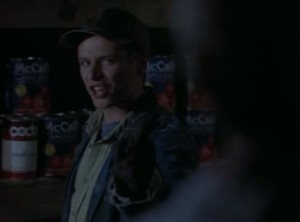
The social fabric is torn apart and accusations fly as the townspeople are forced to bare their true nature to each other.
I have yet to pinpoint the moment in which prolific horror writer Stephen King became his own cabaret act, however it was most certainly long before Storm Of The Century, in many ways another ‘greatest hits’ package of King’s themes and stories. Again, we are presented with a cast of working-class Maine residents with dark – but entirely human – secrets lurking just beneath the veneer of their New England community spirit. Again, it is the presence of a dark figure from Christian mythology who upturns the shared lie of their ordered lives, offering the weakest a choice that will rob them of their humanity and for which the chief protagonists will rail against with righteous self-sacrifice. And again, it takes place in a sleepy town somewhere in between genuine Maine population centres creating a base under siege drama. Even of the villain of the piece may or may not have been seen before. If King wasn’t so good at the formula, it would be so much easier to scorn all but the original attempts at his oeuvre. Storm Of The Century may offer little in the way of new storytelling, but its trademark lengthy build-up of menace and character development work once more to good effect, tense atmosphere all-pervasive, and its villain compelling and well-acted.
Even when the human participants of Stephen King’s novels are rather idealised caricatures of humanity, the author always pulls them away from the edge of schmaltz with his strongly Christian morality of mankind’s frailty. Virtually every adult of Little Tall Island has ‘sinned’, be they adulterers, thieves, drug runners or closet homosexuals lashing out American Beauty -style. Regardless of one’s own perspective on the vices presented, Storm Of The Century’s morals are very black and white, and they need to be in order for the villain to function in the story, judging them from on high for their faults. Some reviewers I have come across online have found the townspeople therefore so unlikeable and hypocritical in their pretense at professing to be good, Christian parishioners, that they have found themselves in many ways siding with the story’s antagonist. Others still have been so disgusted that they refuse to believe such people actually exist. As King demonstrates, it is only extreme duress that people will reveal their inner demons, and the most vehement denial may come from the very people he condemns for their doublethink. How well do we really know anyone? we are compelled to ask.

The strong Christian morals of the story dictate that children are angels and adults have succumbed to temptation. The heavyhanded eulogising is central to the plot.
This, ultimately, is perhaps the true horror of Andre Linoge. Fairly explicit lines of dialogue imply his Biblical origins, a background he shares closely with the chief antagonist of The Stand and the Dark Tower series. Until we find out precisely what he wants of his victims, the tale seems to be the book of Revelation in miniature, except that salvation may lie in wait for no-one once Little Tall’s list of crimes has been read. Yet it is not Linoge’s demonic origins that terrify us, but his ability to force us to drop the masks we hide behind in our attempt at civilization. His disgust at the inhabitants is not so much their hidden criminality, but their pious masquerade atop foundations of insecurity. King’s religious beliefs prevent his characters from adopting the excuse that they are merely behaving as all animals do – the veneer of civilization atop barbarism cannot be equivalent to the skein of sentience thinly stretched across millions of years of instinct. These are a people ‘born in sin’ willfully straying from the path laid out for them by God, and their stubborn denial of their nature dooms them from the outset – able to keep secrets, they are easy fodder for the demon who knows they will tell no-one of his presence. Unsurprisingly therefore, those same viewpoints depict children as beings of perfection – until of course they hit puberty, where sexuality instantly makes them sinners, of which the drama has several such examples. The cynical viewer may put off by the oversimplistic Christian moralising of the piece (not to mention the rather sickening idolisation of the young along the lines proscribed), but will at the same time be compelled by the uncompromising treatment of humanity that unfolds. It may be King’s most Christian-themed tale, but that brutal reckoning of human nature is a common element of his stories that reels his fans in so successfully.
“The cynical viewer may put off by the oversimplistic Christian moralising of the piece (not to mention the rather sickening idolisation of the young along the lines proscribed), but will at the same time be compelled by the uncompromising treatment of humanity that unfolds.”
All of which could fail miserably if not realised well on screen, however, the acting and production values are generally up to the challenge. Filling the boots of self-righteous town hero is actor Tim Daly, known to many as the voice of fellow moral crusader Superman, and possessing just the right looks and bearing to play alpha male and Little Tall Island’s chief of police, Michael Anderson. Daly effortlessly convinces as a well-liked leader figure, more religious than the town priest and more capable than the self-serving town manager Robbie Beals, excellently portrayed by Jeffrey de Munn, who again just looks the part. As does Debra Farentino as Anderson’s wife Molly, who in every way must be alpha in female form, and Farentino delivers. The assembled cast, many wielding that distinctive Maine accent one would expect (and I now know how to pronounce ‘Ayuh’) are by and large as I would have imagined them to be, and every bit as proud and defiant of their superficial outer values as they should be.
Colm Feore, meanwhile, does a fantastic job as Andre Linoge, the dark stranger making impossible demands of the town. Feore gives a carefully balanced performance, neither over-the-top as the part so easily descent into nor too understated to be sufficiently menacing. His Linoge is long-lived, world-weary, and tired of humanity’s self-deception. Yet for all this, he is intelligent and capable of compassion. Murder is seen as a necessity to prove a point, but not something to be dispensed randomly. Feore manages to depict this complexity well, perhaps descending into pantomime only when forced to display Linoge’s animalistic nature.
The character’s supernatural nature is where much of Storm Of The Century’s CGI comes into play, as well as helping render the storm of the title. It’s pretty good for a television miniseries made in 1999, as is the enormous island set used throughout. That we’re on a soundstage is fairly obvious in places, but understandably necessary in order to realise the many practical effects needed to create a town beaten by the weather. This is enhanced further by judicious use of additional shooting in Canada and fairly seamlessly interwoven.
I was in fact only dimly aware that Storm Of The Century had been a miniseries, and watched its entire 4 hours of runtime in one sitting. To me, it had been a surprise find on VCD in Hong Kong the following year and having experienced IT, The Langoliers and King’s 1997 adaptation of The Shining in much the same fashion, Storm Of The Century simply seemed another epic in the same vein. However, this is to undersell the well-paced script, acting and Craig R. Baxley’s direction which are ultimately the reasons why such a long commitment was not overlong. For all its flaws and painful moralising, Storm Of The Century is another successful squeeze of the lemon by a writer in his element. It offers nothing new, but is very good at rehashing the old, and something most King fans will find plenty within to enjoy. And is Andre Linoge Randall Flagg? Let’s not go there.
******
Next Time
As the icy winds of winter depart the northern hemisphere for the south, we’ll be travelling with them all the way down to the South Pole for a special 4-part miniseries on Antarctica. I felt that one week in the massive continent wouldn’t do it justice. The selected films will cover both fiction and non-fiction, through which Antarctica will be viewed as both a place of wonder and exploration, and also a dangerous white wasteland and time-serving outpost for the ordinary worker.
First up, we travel back to a time when the South Pole captured the imagination of the world: On November 1939, two vessels carrying 125 crewmen between them departed Boston for the Antarctic. Travelling with them was a young man about to make filmic history. The first chapter of Antarctic Film Month next, when World On Film returns.
To One In Paradise
This week, a good example of what happens in World On Film when a country of the week isn’t really known for its film industry and I have to find something to talk about. Travel in dubious fashion with me to Bermuda, where we discover why 1966 is the best time to visit, before spending 90 minutes hunting giant turtles while being bewitched by mysterious women.
First though, just a reminder that you can search through this blog’s past history to see what else has been covered through a variety of widgets all to be found at the bottom of the page.
Now, it’s time to away the anchor and set a course:
Destination Bermuda
(1966) The Bermuda Trade Development Board
Safe harbour in Mid-Atlantic, this speck of Mother Earth rimmed round by the great sea, Bermuda: 600 miles from anyplace else.
As the name suggests, Destination Bermuda is a travel documentary produced by the Bermuda Trade Development Board back in the days when the island colony was still Devonshire tea British. While it’s a little unusual for this blog given the nature of the piece, it certainly unveils the Caribbean outpost in all its glory. And yet, it is also the glory of a bygone age, the Bermuda of yesteryear – the unintentional sepia of another world, where it’s almost impossible to imagine it as a serious contemporary invitation to inbound tourism.
Never far from the ocean, the land is carved and shaped to the purposes of the golfer, who seeks the therapy of a club, a ball and 18 holes.
Perhaps unsurprisingly, Destination Bermuda presents the colony as an island resort, wherein the citizens are chiefly concerned with suntans, cycling and golf scores. The fish are so abundant that all one need do is drop an unbaited hook beneath the waves and within minutes, snapper the size of dinner plates helpfully impale themselves upon them in the hope they’ll see their own bodies caramelizing in a frying pan with their last dying convulsions. Men group together upon the rooftops of their shining white houses tossing back the house red after a solid day’s tiling, while the band of the Bermuda regiment regularly parade up and down Saint George in the interests of being vacuously British. Anyone with skin darker than a communion wafer is little more than a colourful addition to the periphery – a reminder that London is many leagues and latitudes distant.
“[The film depicts] the glory of a bygone age, the Bermuda of yesteryear – the unintentional sepia of another world.”
While the fashions and architecture of the day are obvious signs of dating, for me, it was the post-production of Destination Bermuda that really ages it. The rather paternal narration, a sequence of overdramatic lines attempting to be poetic, is delivered in that very measured and deep 60s tone. Ironically, an American artiste provides the voiceover, although as he says himself, Bermuda is a mere “90 minutes from New York”. Likewise the overblown musical score, in true 60s fashion, still clings to the silent film convention of a constant soundtrack, aggressively punctuating the departure of cruise ships with a full orchestra as though they were on their way to Pearl Harbour. The other half of the time, it’s a relentless barrage of harmonica ditties reminding anyone somehow unable to interpret the long band of blue on screen that Bermuda is a sea-based habitat. When one sequence literally broke into Tommy Reilly’s theme from The Navy Lark, I knew I’d been beaten. I half-expected to see one Chief Petty Officer Pertwee wandering up and down Hamilton high street trying to flog off contraband watches. Subtlety, it seems, has never been appreciated in the tourism industry.
This is not to say I didn’t enjoy Destination Bermuda. Its lively, slightly bombastic promotion of the country was all the more entertaining precisely because of its dated production values. It fails in its raison d’etre with a modern audience, but gains new meaning as a period piece. And while the Bermuda of 2010 is obviously a far different place with the dimming of Empire and the change in attitudes and technology, the landscape remains intact, as would the relaxed ‘island culture’ of the place. I left the film having little desire to visit it as it was, but curious to see what it has become.
The airlines don’t promise it and your travel agent can’t swear to it, but somehow, your pilot always manages to show you these islands before you land, for Bermuda perhaps, is a special destination.
Well, you would say that, wouldn’t you?
Travel Film Archive has made the program available to watch via YouTube, so check it out here:
*****
Tourism is all very well, but for me, there was one very iconic Bermuda-themed film from my childhood, involving star-crossed lovers, oceanographers, and giant turtles. Whether it really fits within the blog’s remit is debatable, but it could only be:
The Bermuda Depths
(1978) Written by William Overgard & Arthur Rankin Jr. Directed by Tsugunobo Katani
A young man returns to Bermuda hoping to discover why his father died 13 years earlier and becomes entranced by a mysterious young woman who turns out to be the childhood friend who disappeared into the sea that same day. Somehow, she is connected to his father’s strange fate, but the answers lie out there, in the Devil’s Triangle.
I first saw The Bermuda Depths many years ago and while the plot had faded from memory long since, there was something about it – an atmosphere, perhaps – that remained with me. A recent reviewing went some way toward explaining this, although it also suggested that my tastes were probably less demanding back then. What I see now is a film that has not aged well, unraveled in its designs by bad acting, dreadful special effects and a premise that proves effective only while under the influence of valium. The nonsense of the Bermuda Triangle too was perhaps more alluring in 1978, but seems painfully artificial now, perhaps because the coast guards of the region have been trying to get it through to people that nowhere near as many ships disappear in the area as pop culture would maintain, and those that have did so with a far more mundane explanation than some want to believe.
Others may suggest I’m missing the point of course, and The Bermuda Depths rides high on the wave of piffle the previous decades have built up surrounding this supposedly supernatural island chain. Throw in an emotionally-damaged young man, a family tragedy, an attractive siren in a black swimsuit and legends of archelonian leviathans, and herein is the tale intended to ensnare us from the distractions of logic. Well-done, these elements should come together to form an intriguing mystery and a haunting story of star-crossed love, but the delivery is off both before and behind the camera.
The central character of Magnus Dens, for example, is potentially the most intriguing. Dens, we learn, is an aimless drifter, orphaned by the tragic loss of his parents and directionless as a result. Upon returning to Bermuda, he finds himself entranced by a woman invisible to everyone but the local ‘wise woman’ who places her existence within the framework of a centuries-old curse. Rejecting the madness of the one person who believes him, Dens is treated with pitied sympathy by his friends, certain his crumbling psychological state is torturing him with the hallucinations of an imaginary friend. This, to me, demonstrates wonderful scope on the part of the lead that should lend true anguish and drama to the conflict. Unfortunately, actor Leigh McClosky brings this complex character to life with all the energy of a deflating balloon, his languid stares and lethargic movement interrupted at times by over-the-top aggression meant to signal an unleashing of his inner turmoil, but coming across as two-dimensional overexcitement. While I have no problem with the supporting cast, their efforts cannot make up for McClosky’s inability to act. Even the lovely Connie Sellecca’s superior performance as the almost spectral seductress Jennie – a subtle miasma of innocence and eternal regret – can only do so much when this is whom she must play against, although it’s likely no coincidence that it is with her that McClosky gives his best performances, Sellecca seemingly bringing out in him capabilities elsewhere hidden from view.
“[The Bermuda Depths] is a film that has not aged well, unraveled in its designs by bad acting, dreadful special effects and a premise that proves effective only while under the influence of valium.”
That said, William Overgard’s script clearly isn’t interested in being the character study it ought to in favour of a shallow pastiche of ‘Moby Dick’ vying for time with the elements of unrequited love. There’s no reason we can’t have both, but efforts to champion one direction come at the cost of another, perhaps in a desire to provide spectacle. This unfortunately is where the film’s low budget really becomes evident, with some very cheap and unconvincing model shots, special effects and atrocious day-for-night shooting , which admittedly I don’t recall being such glaring problems 20 years ago. The Bermuda Depths is one of those films that holds together far better not simply in the distant past when it was made, but in that hazy distance of memory, which over time smooths out the inconsistencies. It’s a little like being reunited with your first love and finding that much of what you recall about it has been rose-tinted in the years since.
The soundtrack too is an odd mish-mash of styles reflecting the shifting, unevenness of the plot. A haunting period theme song suggests temptation and seduction, giving way to a recurring (and indeed familiar) classical guitar motif, both of which must coexist with a strange retro thriller score that reminded me at times of orchestrations Malcolm Lockyer was creating in 60s sci-fi matinees. The final element of what one today might call ‘muzak’ fills out the dramatic downtime. The overall lack of coherence suggests the differing perspectives behind the scenes and a loss of clarity.
One thing that has not suffered from the passage of time, however, is the location itself. All exterior scenes were shot in Bermuda and its sleepy urban landscape, powder-white beaches flanked by picturesque rocky outcrops and azure sea go a long way toward compensating for other deficiencies. The local government, credited for assisting in the making of the film, would doubtless have seen it as an enticing travel promotion and deservedly so – it certainly worked on me. The natural landscape lends itself perfectly to the storyline and ultimately, it is only the artificial enhancements of post-production, weak plotting and character development that don’t stand up to scrutiny – especially to a modern audience.
Ultimately, these are the dangers of revisiting the past and the way it is often defeated by the ravages of time and the changes we undergo as a result. Ironically, this mirrors The Bermuda Depths rather well. The film itself is the beckoning siren, luring the rose-tinted memories of an ageing audience toward potential heartbreak, and like the ancient mariners, I failed to lash myself to the mast in time.
*****
Coming Up Next
Bhutan is another nation not known for its film industry, but it does produce film directors. One of them fairly recently produced Milarepa, famous Tibetan poet and yogi of the 11th and 12th Centuries, whose early life was fraught with poverty, misery and anger until he learned to rise above it. While the man himself was entirely real, the legends surrounding him slide into the realm of fantasy and magical melodrama, and it is to this realm that we will be exploring next time.
To view a trailer, click below:
Chinese Whispers
This is a follow-up to last week’s post in which I reviewed Jonathan Miller’s memorable screen adaptation of the M.R. James classic short story, Oh Whistle And I’ll Come To You, My Lad. Below is my review of the recent ‘remake’. You may wish to read the previous entry first to get the whole story.
Whistle and I’ll come to you
(2010) Teleplay by Neil Cross Directed by Andy De Emmony

John Hurt stars in ‘Whistle and I’ll come to you’, 2010’s highly-disappointing reinterpretation of Jonathan Miller’s teleplay, reviewed in the previous entry. Hurt himself however is one of the train wreck’s redeeming features.
I think it’s important to begin by saying that the BBC’s efforts to bring the classic ghost stories of M.R. James to the small screen, have, over the years, been a continual source of joy for lovers of old school horror such as myself. While not every adaptation has been as accomplished an approach to film-making as Jonathan Miller’s iconic 1968 retelling of Whistle & I’ll Come To You and Lawrence Gordon-Clarke’s memorable interpretation of A Warning To The Curious, even the comparatively more pedestrian entries have evoked not only the much-anticipated foreboding and supernatural atmosphere of the source material, but a good degree of faithfulness to their underlying themes. Indeed, the BBC proved that this intuitive understanding of this literary fidelity was still very much alive when the classic ‘Ghost Stories For Christmas’ series was revived in the 2000s with the worthy additions, A View From The Hill and Number 13. This, however, cannot be said for 2010’s apparently necessary remake of Whistle And I’ll Come To You, wherein the terms ‘remake’, ‘intuitive understanding’ and ‘source material’ are applied with the same degree of dubiousness as any arguments in support of the production’s validity.
For those unfamiliar, as indeed many still will be after watching the new Whistle, the plot of the original centres around the cocksure academic bachelor Professor Parkins (Parkins in the original text), who takes a vacation during the off-season at a remote Norfolk seaside village for golf and exploration, the latter prompted by a colleague’s request that he inspect the remains of an old Templar preceptory to determine its archaeological worth. This he duly does, and within the crumbling ruins, discovers an ancient whistle, unable to resist putting its practical function to the test. From that moment on, Parkins is never alone, having awoken forces beyond description and quite beyond all human understanding. The heart of the story is the folly of arrogant presumption, that there will always be realms of understanding beyond mortal man, and to believe you can quantify existence is to invite downfall. James’s overconfident scholar and protagonist is the perfect vehicle to deliver this message, and an archetype that the writer, who was himself a highly-accomplished academic, knew better than most. The rapid destruction of Parkins’s self-assured, almost autistic world is almost as disconcerting as the unknown forces he has unleashed, for which we are given only fleeting glimpses and very little explanation.

Gemma Jones as Alice Parkin, whose presence greatly humanises the main character, thereby entirely undermining his raison d’etre.
All of which clearly flew over the heads of the 2010 production team, who presumably felt that the core elements of the story were its beach setting, the university professor more inclined to the rational than the superstitious, and the general bleakness of his existence. So long as some vague continuity with these components was maintained, it seemed perfectly reasonable to completely rewrite both story and characterization to the point where the result was a vague shadow of its former self yet could still be legitimately broadcast under the same title.
The Neil Cross teleplay, in which the action is relocated to the present day, sees a Professor James Parkin committing his wife, apparently suffering from advanced senile dementia, to a care home before taking a long overdue vacation on the Kentish Coast in order to come to terms with his loss. The seaside resort also happens to be their one-time honeymoon destination, and the discovery of a ring in the sand dunes brings to life more than mere memories for Parkin. Something seems keen to communicate with him on the deserted coast, and it may not be as unfamiliar as it first appears.
Cross’s script quite spectacularly fails to grasp the point of the James tale, retaining only superficial vestiges of its substance. Gone is the arrogant, antisocial university mandarin of the original. In his place is the more socially-capable doting husband whose rational worldview is in no way extreme and borne of great personal tragedy – again entirely caused by the most intimate of social interaction (the original Parkins wouldn’t even know what to do with a woman). The character’s ultimate fate is seemingly more extreme, yet far more simplistic and obvious, undercutting the psychological ramifications of his plight.
“Cross’s script quite spectacularly fails to miss the point of the James tale, retaining only superficial vestiges of its substance.”
The ‘ghost’ of the story is equally less subtle and, by the climax of the tale, extremely more quantifiable than its antecedent, of which one understands no more by the end than they did when it first appears. Its intangible mystery is precisely the point of its existence, being something so alien that not even the well-read professor can define it.
The whole dramatisation is, in short, comprehensively dumbed down. The rapid departure from the original narrative is, according to those behind the camera, because Jonathan Miller had already dramatised the story so well that there seemed little point in retreading the same ground. The truncated title, the fact that the character is named Parkin and more significantly, that he is middle-aged, are further clear signs that it is the 1968 Omnibus adaptation rather than the book from which inspiration was drawn. The reigns are firmly in the grip of Marshall McLuhan’s prophesied generation wherein the televisual medium has become the message for those who work in the industry. Television is its own reference point and must now be the source material for rehashing plots with diminishing returns. Heaven forfend that the book be the wellspring of inspiration instead. Telling the same story is surely the point, and the fundamental element of a remake. Artistic vision and execution are surely the obvious ways in which it can be taken in new directions. And if there is little point in retreading ground well-covered in the past, this, surely, is proof that the exercise was unnecessary in the first place.

Kingshead and Botany Beach on the Kentish coast provide some excellent backdrops. Certainly the casting and production values are not at fault here.
Cashing in on a popular title is perhaps the greatest offence and indeed irony, since the Cross script under the direction of Andy De Emmony does deliver its own chilling moments. Add to this the very capable cast headed by John Hurt and Gemma Jones and some excellent location shoots, and there is much to otherwise praise. More damage is done to it by being arrogant enough to masquerade it as something it is not, whereas a more favourable analysis would be quite easy if it were touted as a new work in its own right. It isn’t, however, being instead an unwarranted ‘Disneyfication’ of a far darker psychological piece that a new audience will mistakenly equate with Britain’s greatest master of the macabre. It is the same blind egotistical behaviour that Hollywood is typically blamed for. With them, however, such silliness is expected.
*****
.
Next Time
As indicated last week, World On Film will be going all Nollywood for the Benin-themed film, Abeni. I’ve even found a trailer, which you can see here. No subtitles, but you’ll get the general idea.
The Summoning
World On Film takes a side-step this week as its author, in the grips of the festive season, festively gets to grips with an old Christmas tradition.
Some years ago, when I was abandoning the bloated, overpriced and utterly tedious corpse that Christmas had then become and keeping only the core elements that made sense to me (decent food, wine, the company of people genuinely close and a few laughs), I realised one key element of traditional Northern European yuletide festivities was missing: ghost stories. Enjoyable horror, as opposed to the dreaded misery of the Eastenders Christmas Day special, the terrifying wit of Graham Norton and the bone-chilling inevitability of a youthful Aled Jones. Thankfully, the BBC have over the years seen fit to adapt the work of yesteryear’s masters of the macabre, such as J.S LeFanu (Shalken The Painter), Charles Dickens (The Signalman) and many dark outings from the greatest British scribe of the Victorian ghost story of them all, M.R. James.
Indeed, 2010 was the year one of his most popular tales would be remade for a modern audience, but before it is held up to scrutiny, World On Film explores the still-powerful original, that being:
Whistle And I’ll Come To You
(1968) Written by M.R. James Teleplay & Direction by Jonathan Miller
“There are more things in heaven and earth than are dreamt of in philosophy.”
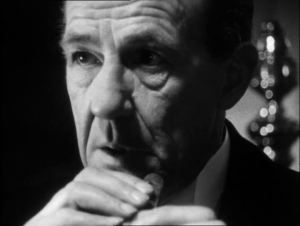
'Who is this that is coming?' Michael Hordern summons the unknown in the classic M.R James tale, 'Whistle And I'll Come To You'.
(To see a brief clip, look to the bottom of last week’s post.)
A university professor, arrogantly believing he holds all the answers to life, the universe and everything, faces the ultimate horror during a vacation at a quiet coastal village in Norfolk when he encounters something that goes beyond all rational explanation.
It was a rather bleak and overcast afternoon several years ago when I happened to catch Whistle And I’ll Come To You, Jonathan Miller’s excellent adaptation of Montague Rhodes James’s signature ghost story. The iconic tale was my first visit to the Jamesian world of understated Victorian horror – a world he seemed to inhabit effortlessly – and I would as quickly as possible go on to devour every other work that I could get my hands upon. Although Whistle is a very different beast in many ways to the original short story upon which it is based, Miller expertly brings the essential underpinnings of the tale to life with a balance of modification where perhaps budget intervened, and fairly instinctive faithfulness. Filmed some 50 years after it was written, it is almost that long again since and the monochrome retelling still has the power to delight and scare.
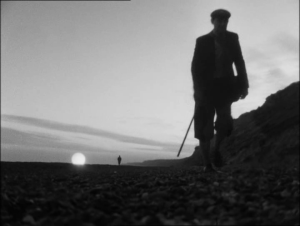
The quiet build-up of menace and terror, almost unnoticed at first, quickly became the James trademark, now standard practice in old school horror.
Miller seems to grasp the author’s restrained and quiet approach to drama effortlessly. James belonged, and very comfortably inhabited, the old school of literary horror. It is a discipline largely of the implied, of the vaguely-suggested, an enormous sepulchrally-lit room wherein the rational must fight to be heard and, finding no familiar ground, is often mercilessly subdued by that which it cannot define. It is the world of the oblique and the unseen, save for a few terrifying half-interpreted glimpses into a forbidden dimension of chaos, the dark denizens of which will inflict upon the ordinary man only terror and madness should he gaze upon them too closely, or worse still, attempt to make sense of them. Even the most intact survivor is forever changed and robbed of all previous convictions. It is, in essence, a horror that derives from what is unseen save for a few tantalising details that will unseat the ego carefully crafted to cope with the everyday world and shatter the anthropomorphic world view. While Dickens did not attempt, like James, to glimpse at the Hadean talons behind the shadows, he nonetheless understood the fundamental mechanisms of the genre: The Signalman is a celebration of the power of description set within maintained unease. Much of the drama is down to the buildup of suspense and atmosphere, with the audience left largely to draw their own conclusions in the theatre of the mind, save for one or two terrifying, yet tantalizing and well-timed glimpses into the abyss provided by the writer. Lovecraft, the successor to both authors, carried on the tradition of reluctant descriptive prose for the purposes of implication, where the full revelation opens the curtains with unsubtle recklessness, calls in the daylight and the mood is forever destroyed.
“[Director Jonathan] Miller expertly brings the essential underpinnings of the tale to life with a balance of modification where perhaps budget intervened, and fairly instinctive faithfulness.”
This approach, now the benchmark of the proper ghost story, is precisely what we get in the teleplay, shot on location in Norfolk, where the scenery and incidental sounds do much of the work. This is especially important given that the overconfident lead character, who almost entirely inhabits a world of his own creation and does not engage in a great deal of dialogue. The less-is-more approach is wonderfully effective: much of the tension comes from nightmarish dreamscapes and strange objects ominously kept in the distance, and the lack of continuing verbal commentary allows for wonder and suspense to build to great effect. And indeed the true horror is psychological: that which cannot be qualified, a true terror to one who thinks they have reality fully understood, and poignantly, one they have brought entirely upon themselves. The monochromatic nature of the film lends to the bleak and cold surroundings of the Norfolk coastline, although as viewers were to find in the BBC’s next James adaptation, A Warning To The Curious, full colour is by no means more comforting.
Headlining the cast, the late and legendary Michael Hordern is a good deal older than the Professor Parkins of the text (Parkin in the film), which unfortunately loses the idea of arrogance in one so young, but Hordern is such perfect casting and fits the character so well that one can more or less forgive the character’s transformation. The other principal lead of the Colonel, played with great understatement by Ambrose Coghill, also finds his part reduced in the teleplay, although his conversational foreshadowing, in which he suggests that the realm of knowledge may be greater than Parkin smugly allows for, is crucially intact. Indeed, Miller’s assured hand preserves the essentials of the storyline and ensures that things move at a consistent pace, realising the ambiguous supernatural elements with skill to a satisfying conclusion.
Any fan of classic horror would be doing themselves a disservice to pass on this marvellous visual retelling of one of M.R James’s most celebrated ghost stories. Even now, as a new version is about to hit the small screen, I will be very impressed indeed if it manages to surpass the wonderful and original monochrome masterpiece.
*****
The Creature That Came In Answer
The following section is a comparison of the film and the original short story. Please do not read this section if you haven’t seen/read either and don’t wish to be spoiled. Scroll down to Further Reading below therefore to avoid any major revelations.

Miller takes great care to capture the enormous distance between the self-contained Professor Parkin and everyone around him.
Jonathan Miller’s monochromatic adaptation of ‘Oh Whistle, And I’ll Come To You, My Lad’ was the first time the story had made it to the small screen. That very same year however saw Robert Eddison (probably best known today for his portrayal of the Grail Knight in Indiana Jones & The Last Crusade) star in the fourth James adaptation for the highly-successful ITV anthology series Mystery & Imagination, ‘Casting The Runes’. Whistle was also part of an anthology series, though unusually, it was the BBC’s long-running Omnibus program, primarily known for its documentaries on a variety of subjects.
Those familiar with the original short story may consider Miller’s efforts to be a somewhat truncated version of the tale, with character motivations removed and certain key scenes omitted from the film. Even the title (a line from a Robert Burns poem) has been shortened, as if symbolic of Miller’s desire to distill the story down to its core potency. It is a Professor Parkin, not Parkins, who comes to the remote Norfolk seaside village for recreation. He is middle-aged rather than young, and is entirely disinterested in golf, while for his literary counterpart, the sport forms fully half of his reason for choosing the venue. Golf appears frequently in James’s short stories as the sport du jour of the upper-middle class academic, though he is often dismissive of it, as in ‘The Mezzotint’, where it is enough to mention the fact that the main characters spend an afternoon on the green, “but [the details of] which the conscientious writer has no right to inflict upon any non-golfing persons.” Ironically, a significant golfing scene occurs in ‘Oh Whistle, And I’ll Come To You, My Lad’ between Parkins and the Colonel, who becomes annoyed at the young professor’s prowess. The sport becomes the common ground for their growing relationship and when not searching the sands for a Templar preceptory, they often found in each other’s company. By their second golfing game, “they got on so well together in the morning that there was no talk on either side of their separating after lunch.” On television however, they merely know each other through mealtime conversations and from this principally is their relationship developed.
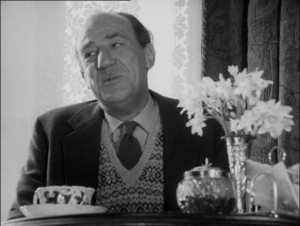
Though significantly older than the Parkins of the text, Michael Hordern expertly captures the cocksure nature of the lead character, assured that the world is easily quantifiable.
Of course the Templar preceptory, a crumbling ruin largely buried beneath the sand on the shores of the beach, becomes instead a more modern Christian cemetery upon the embankment high above the beach. Doubtless Miller would have been only too happy to have showcased the former if an obliging Norfolk beach had presented itself (filming in Lincolnshire might have yielded results), though the ridiculous ease with which Parkin finds his whistle is entirely faithful to the equal good fortune Parkins has within the sand. The absence of the preceptory also robs Parkin of another of his ambitions while in the area. In the short story, it is a fellow colleague who asks him to check the ancient ruins to see if “it would be any good to have a dig there in the summer.” On television, it is Parkin who plans his visit to the cemetery, simply to indulge his own curiosity.
“Those familiar with the original short story may consider Miller’s efforts to be a somewhat truncated version of the tale.”
The ghost of the story is largely the same in both versions. In the climax to the short story, it is “a horrible, an intensely horrible, face of crumpled linen” (sic), as if framing the face of the invisible monster within. As with the not readily available Templar artifacts, Miller does not quite have the technology to reproduce such a visage, which the prose so successfully invokes in the theatre of the mind. One final noteworthy absence is the earlier scene involving a small boy terrified out of his wits upon seeing a white sheet rise up to the window of Parkins’s room seemingly animated by nothing of the material world. The youngster, half-crazed, relates the vision to the room’s occupant, foreshadowing the nightmare he will soon experience for himself. Given that it is a related tale rather than in real-time, Miller perhaps has decided that it would undercut the ghastly revelation of the haunted bed sheet.
Here then we return to the idea of distillation, for despite the many trims made for the screen adaptation, there is no doubt whatsoever that Miller has understood the heart of the tale. While not “young, neat, and precise in speech”, his Professor Parkin is no less arrogant and cocksure, more than content to the point of preference to inhabit a world populated exclusively by himself, with human company welcome only either for the purposes of showing off. Company becomes more desirous when this world is thrown into disequilibrium. Parkin is less “precise” in his speech however, often so caught up in his perpetual interior discourse that words are frequently fumbled and sentences disjointed. Parkin’s disinterest in golf, the one opportunity Parkins of the text has to maintain social interaction, makes the elder character of the film even more isolated and withdrawn.
The decision to make Parkin older may have come down entirely to the casting of Michael Hordern, who captures the haughty academic perfectly. Hordern gives Parkin a delighted self-assurance that his world view defines the very building blocks of the universe, only later to quickly unravel when the paranormal sends him into meltdown. He engages in frequent muttered dialogue with himself, chuckles happily at his genius, and generally glides through life seemingly unaware of it. At the climax, Hordern wonderfully plays Parkin’s abject horror at the indescribable, the inexplicable reality that nearly destroys him, and unlike the text, this is also the point at which the credits roll, giving no hint of how successfully he will recover, if it all.
“Michael Hordern captures the haughty academic perfectly… giving Parkin a delighted self-assurance that his world view defines the very building blocks of the universe, only later to quickly unravel when the paranormal sends him into meltdown.”

The bleak but powerful Norfolk coast provides some excellent locations, helping to lend faithfulness and authenticity to the adaptation. Does anyone know where this groyne is exactly?
Similarly, although absent of any Crusading knights’ stronghold, the filming locations are otherwise very authentic and faithful to the original. The lonely Norfolk coast is every bit as isolated as the text describes it: “On the south you saw the village of Burnstow. On the north no houses were to be seen, but only the beach and the low cliff backing it.” Indeed, only the guest house appears on screen as proof civilisation’s existence, making sandy shores even more remote. The interior of the brightly-lit residence is a sombre space, where sound is an exception rather than the rule. Indeed silence plays a huge part of the production, with Miller keen to emphasise not only the great isolation of the world Parkin has stepped into, but the tremendous distances between himself and the rest of humanity. The monochromatic nature of the film only serves to emphasise the gloom.
Technological limitations aside, the apparition of the story is recreated more or less as one would expect it to appear. More importantly, the slow build-up wherein the ghost’s presence is felt more than seen except occasionally in the distance, is entirely faithful and effective. The dream sequences are very carefully actualised so as to appear as they did in prose, even down to the fact that no matter how often Parkin opens his eyes, the nightmare instantly returns when he closes them again; while the odd pulsing sound effects expertly build up the tension of pursuit and menace, with the beach groyne described in the text shot from below to good effect. In all the places where it matters, Miller has remained as faithful to the original as his 1968 budget and technical capabilities have allowed him to be. Coming in at approximately 41 minutes, the adaptation is just long enough to build up the slow, but steady pace of the source material without being too long so as to lose momentum.
Christmas Eve 2010 saw this most celebrated of Jamesian ghost stories return to the small screen. It too bore the name Whistle And I’ll Come To You and starred John Hurt in the lead role – both suggesting that it may owe more allegiance to its television predecessor than the short story itself. That however, is for another time.
*****
Further Reading
The short stories of M.R. James are now out of copyright. Subsequently, you can read ‘Oh Whistle, And I’ll Come To You, My Lad’ right here for free. ‘The Mezzotint’, also mentioned above, can be read here.
*****
The End of the Beginning
And with that, we come to the final entry for 2010. There will be no ‘proper’ update next week while I, and very likely the rest of you, ring in the new year. However, I may write a follow-up to this post praising or lamenting the remake of Whistle.
Otherwise, World On Film returns in early January to continue the ongoing mission. Coming up: childhood sweethearts reunited, but their parents have other ideas for their marital futures. Love and melodrama in Benin as we explore the Nollywood flick, Abeni.
Breakdown
Welcome. Let’s jump straight into things this week with the entry for Bangladesh:
The Clay Bird
(2002) Directed by Tareque Masud
“The bird’s trapped in the body’s cage. Its feet bound by worldly chains, it tries to fly, but fails.”
‘The Clay Bird’ opens a door into Bangladesh’s fight for independence in the late 1960s when the soon-to-be nation state was a far-flung region of Pakistan, following the partitioning of India in 1947. Increasingly disenchanted with the distant central government due to racial, cultural and economic discrimination, Bangladeshis began taking to the streets in protest, demanding a general election as the springboard for autonomous rule. The election was cancelled and the Pakistani military were sent in to quell the uprising, murdering thousands and destroying population centres. A civil war ensued, eventually leading to independence in 1971. The film is set just prior to the prolonged and bloody uprising, as citizens find themselves galvanized along religious and political lines, with tempers beginning to fray. Rather than depict events at the heart of the capital, the story centres around the lives of a rural family in a remote village, bearing witness to the way in which the winds of change blew across the ordinary citizen. While the intent of this is sound, the end result is something of a mixed bag.
The plight of the family proves an effective allegory for the various Bangladeshi attitudes to the turmoil their world is in. Kazi, the father, a born-again Muslim, reflects the ultra-conservative stand that faith and discipline will unite the people under Allah, and is unable or unwilling to accept that the deeply fractured society around him faces problems that cannot be solved through prayer. Milon, his brother, a young political extremist, stands ready to fight for the nation with the unwavering confidence of the just. Ayesha, Kazi’s apolitical wife meanwhile, is interested simply in getting through the ordinary day to day struggles of life. Asma, the daughter, is too young to be constrained by the petty concerns of adults, while Anu, the young son, is propelled unwillingly by conflicting forces and ideologies he doesn’t understand. It is the nation in miniature, about to burst at the seams.
“[The family] is the nation in miniature, about to burst at the seams.”
Yet there is a somewhat meandering quality to the pacing, perhaps in part because the writer has not entirely decided upon the story he wants to tell. It could very easily simply be the story of a young boy forced to attend a madrasa (Islamic boarding school) by a father terrified his son’s mind will be polluted by non-Islamic ideas and therein be a commentary on Islamic extremism itself. Indeed, a large chunk of the film is just that: there is a very telling scene where the young Anu and his uncle watch a Hindu boat race, clearly enjoying themselves, only to be reprimanded for celebrating diversity. Kazi’s religious fervour has him at odds with the rest of his family, incapable of being the father and husband they so desperately need. The dogma strangles the family to the point of dysfunction. Equally telling is the character of Milon, whose more secular and open-minded world view is the foundation for the forthcoming nation-state. Religious dogma is equated with denial, while the activist is the realist.
Fortunately, the Islamic discourse eventually digs deeper and there is a nice scene where two of the madrasa teachers make the point that the religion spread so successfully across Bangladesh precisely because it was a peaceful ideology. Whatever one’s beliefs, there can be no denying that this sort of discourse on Islam is rarely found outside of Islamic countries. The very idea that it must be spread by force and violence is just such a question pondered with dismay by one teacher struggling to understand how religion became part of the rising civil war in the first place. That the Muslim extremists involved in acts of terrorism rivaling the invading Pakistani army might be missing the point is one of the many tragedies of that war, though it is important to remember that many factors came into play, not least cultural and economic destitution. However, director Tarique Masud does not adequately explore these factors, which if the aim is to give a snapshot of society during that time is quite remiss, suggesting that he is more interested on religious commentary. Yet the film goes beyond the madrasa, so that those set up as the main characters then disappear for long stretches like the inhabitants of a Tolkien novel. This unravels the sequences designed to build up character storylines, with the disjointed result leading to the uneven pacing. This leaves the conflicts faced by some to be either insufficiently built up or not satisfyingly followed through. Masud ultimately needed to choose one storyline and stay with it.
“There is a somewhat meandering quality to the pacing, perhaps in part because the writer has not entirely decided upon the story he wants to tell.”
Nonetheless, the cast perform with the conviction and skill necessary to draw the viewer into their characters’ worlds – when we are able. However, standouts for me include Russell Farazi as Rokon, Anu’s one true friend at the madrasa – a likeable, yet misunderstood loner, and the young Farazi is more than able to imbue the character with the complexities that reside in such a part. Soaeb Islam, meanwhile, brings to the wannabe revolutionary a warmth often without any dialogue whatsoever. Clearly, Kazi is set up to be a stiff-necked Islamic convert, giving Jayanto Chattopadhyay not a lot of range, however, this does allow for a meaningful scene at the end where the horrors of war force Kazi to face his religious convictions. And while Nurul Islam Bablu is no Marina Golhabari, he gives Anu the profound innocence that the script requires of the character.
Ultimately, ‘The Clay Bird’ is not quite the tale of Bengali struggle it purports to be, due to unfortunate scripting and editing choices that take much of the wind out of its sails as a result. However, it opened up a window into a history with which I was hitherto unfamiliar, with many thought-provoking and sometimes touching sequences that still manage to shine through – even if the sum of the parts is conspicuous by its absence.
*****
The Memoirs Of A Self-Confessed Surrealist
(1978) Directed by Alan Yentob
“The marvellous is beautiful. Anything marvellous is beautiful. In fact, only the marvellous is beautiful.”
In 1978, jazz player, film critic, writer and lover of melting watches, George Melly, undertook a journey from his Notting Hill home to visit the Great Exhibition of Dada & Surrealist Art at the Hayward Gallery near the Thames. Along the way, he relates his long and passionate love affair of the surrealist movement and its many colourful denizens, reliving many experience of his own both surreal in encounter and Dadaesque by design.
Melly recounts how he joined the British surrealist movement after serving in the Royal Navy during World War II after discovering the book Surrealism by Herbert Reed, the paintings within revealing “a world I’d always suspected had existed, but which I didn’t know how to get into.” To him, surrealism “is the spirit of the dream, coupled with reality” – a world based firmly upon reality, but overlaid with the heightened states of imagination contributed by the participant. This is an important distinction from fantasy, where the impossible has been divorced from the everyday and celebrated. Surrealism is firmly grounded in the ordinary, but through the freedom of imagination is able to perceive it as the marvellous. Even Salvador Dali had to be an impressionist before he could depict the inner world within. The surrealists embraced convention, recognising that they could be easily dismissed if they fitted the stereotype of the artist. Those like Magritte, who were far too busy challenging perceptual reality to bother with extravagance, were more successful with this aim, while for Dali, extravagance was the point.
“Oh, Dali. What a genius you were, and what a sad clown you have become.”
‘To [Melly], surrealism “is the spirit of the dream, coupled with reality.”’
The surrealist world according to Melly is a close-knit community, a movement shared in full agreement by his members. This is perhaps unsurprising, given that Melly knew most of its primary practitioners personally, his own surreal poetry entering the canon of which notable entries lament the loss of a friend.
“When Magritte died, the stones fell to the ground, the birds divorced their leaves, the breasts became blind, the tubas extinguished their flames, the pipe remembered its role, the words looked up what they meant in the dictionary, the ham closed its eye forever, when Magritte died.” – Excerpt from “Homage to Rene Magritte”, by George Melly
Likewise, he is able to name check the likes of Marcel Duchamp, Man Ray, ELT Mesens, Giorgio de Chirico and Max Ernst with anecdotal clarity. The poetry of Dadaist Kurt Schwitters once saved his life in a dark alley, while the simple, yet revolutionary words of Andre Breton in a conversation decades earlier helped him expect the unexpected from the ordinary. Weekly gatherings at the Barcelona Restaurant in Soho brought him into contact with violin-torturer Robert Melville, pacifist air-raid warden Roland Penrose, suspected Fifth Columnist Conroy Maddox, and anarchist bus conductor Arthur Moyes among others. Inheritors to the surrealist oeuvre are introduced, notably Monty Python, painter Patrick Hughes, blue novelist and fashion guru Molly Parkin, and British rock band The Stranglers, although surely The Stranglers were Dadaists, since as Melly says himself in description of the movement, “the beginnings of Dada were not art, but disgust.”
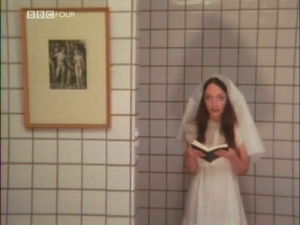
Visitors to a famous Max Ernst exhibition entered through a bathroom in which a teenage girl read dirty poetry.
The long journey includes, as one might expect, plenty of visual examples of the Dada revolt and the Surrealist reinterpretation, from the paintings that still inspire wonder in the minds of many today to the buildings that were created as a result. When not heard to ‘ursonate’, Melly’s poetry parts the clouds of conventional thinking and forces all ears to see the world in-between. It is, after all, a personal journey, and for fans of the genre, a quick and entertaining celebration of everything that makes the movements so exciting and fires the flames of marvellous creativity. For the novice, it serves as an entertaining introduction to the surrealist and Dadaist movements, the key works of both, and the artists who created them. As to availability, BBC4 occasionally repeats it along with other Arena classics, otherwise look online in the usual places.
*****
Next Time
Life, death, love and anguish, as the lives of 14 Belorussian businessmen take centre-stage in the documentary Brigade, or A Toast To A Clean Friday, part of Rutger Hauer’s I’ve Seen Films short film festival.











